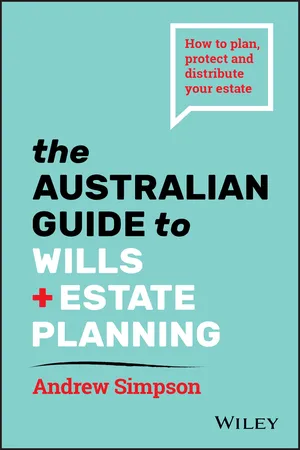
The Australian Guide to Wills and Estate Planning
How to Plan, Protect and Distribute Your Estate
- English
- ePUB (mobile friendly)
- Available on iOS & Android
The Australian Guide to Wills and Estate Planning
How to Plan, Protect and Distribute Your Estate
About This Book
Where will your wealth go when you go? Get peace of mind for you and your family with current and valid estate planning.
The Australian Guide to Wills and Estate Planning helps you leave your wealth to your selected beneficiaries, avoid family disagreements and protect your financial legacy. This plain-English guide makes estate planning easy — providing exactly what you need to know to get started.
You have spent substantial amounts of time and energy creating your wealth. However, planning how your wealth is to be distributed after your death likely receives little attention. It is common for people to consider preparing a will only when a personal life event brings the topic to the fore – the death of a family member or close friend, a personal health issue or overseas travel. The emotional stress and time constraints associated with such circumstances are avoidable if you plan your estate today.
Wills and estates expert Andrew Simpson shares his extensive knowledge to help answer your questions and prepare for the future today. From planning your retirement, to writing a will, to distributing your assets, each aspect of estate planning is highlighted by informative case studies, practical examples and easy-to-read explanations.
This clear, jargon-free guide answers your estate planning questions and enables you to understand the fundamentals of the estate planning process. Designed specifically for readers with little to no experience with wills and estate planning, this book will help you:
- understand the vital aspects of the estate planning process
- know what to look for when choosing a professional estate planner
- minimise tax burdens for yourself and your family
- use trusts to safeguard your assets
- protect your will from legal challenges.
With the latest financial and tax guidelines, this is a must-have resource for anyone seeking to confidently pass on their wealth to future generations. The Australian Guide to Wills and Estate Planning is for anyone wishing an easy, stress-free way to sort their affairs and enjoy peace of mind.
Frequently asked questions
Information
Part I
Understanding estate planning
Chapter 1
What is estate planning?
- Whether we like it or not, all of us will die.
- The timing of our death is unknown.
- We can’t take anything with us when we die!
- ‘Estate’ — indicates that the process is concerned with a period of time following your death. This aspect is guaranteed: we are all mortal.
- ‘Planning’ — refers to the need to organise your affairs during your lifetime. This aspect is not inevitable. It requires action.
Why is estate planning important?
- Overall wealth has increased. This is due partly to the significant increase in superannuation contributions since the introduction of the superannuation guarantee in 1992. It can also be explained by the real estate boom that has occurred in most states of Australia that has seen the median house price in the capital cities increase significantly.
- Australia’s social fabric has changed enormously. The traditional family structure is now no longer the norm. Data from the Australian Bureau of Statistics in June 2016 predicted that the number of couple families without children is projected to become the most common family type in Australia between 2023 and 2029. Statistics have also confirmed that in recent decades trends in divorce and remarriage have contributed to changing numbers of one-parent, step and blended families. As a result, more deliberate planning is required to deal with such diversity.
- The use of alternative investment structures such as trusts, companies and self-managed superannuation funds has increased. The Australian Taxation Office estimates that as at 30 June 2017 there were more than 600 000 self-managed superannuation funds in existence in Australia with more than 1.1 million members.
- Australia’s population is ageing. Figures provided by the Australian Bureau of Statistics suggest that 15 per cent of the Australian population is currently aged 65 and over. By 2030 this percentage is predicted to be more than 20 per cent. The number of Australians aged 85 and over is expected to quadruple between 1999 and 2051. The life expectancy of Australians is also increasing. This changing demographic has brought with it novel estate-planning issues that tend to be age specific, such as the consequences of a reverse mortgage and the implications of a move into aged care.
Features of estate planning
Estate planning must be tailored
- family members who require special treatment because of a disability, addiction or other health concern
- antiques, family heirlooms or collectables that need to be dealt with specifically
- business interests
- family circumstances, such as a second marriage or children from different relationships
- potential challenges to your will
- the existence of a self-managed superannuation fund or other trust structure.
Estate planning needs to be flexible
CASE STUDY
Estate planning must be understood by you
Table of contents
- Cover
- Title Page
- Copyright
- About the author
- Acknowledgements
- Preface
- Part I Understanding estate planning
- Part II The will
- Part III Trusts and estate planning
- Part IV Taxation and superannuation
- Part V Lifetime planning
- Part VI Estate planning and elder law
- Glossary
- Appendix: Step-by-step estate planning guide
- Index
- End User License Agreement